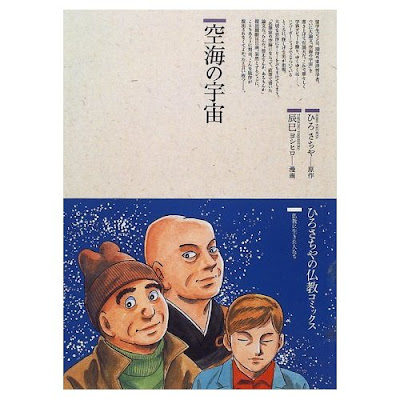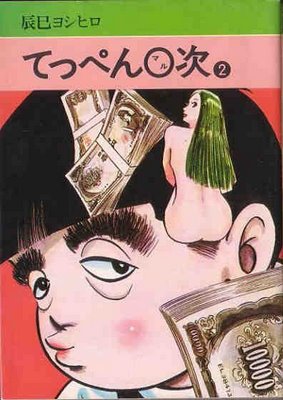On Tuesday I posted some covers of women doing violent stuff. Here’s another installment of cover scans, one you can call either “Odd Stuff of the Golden Age” or “Tom: His Many Moods.” The covers here are all from comics that have sold for hundreds or even thousands of dollars. They’re big on the collectors market, and not because they involve famous characters or huge name artists. People want these comics just because the comics look so weird.
Gluey Tart: Restart

Restart, by Shouko Hidaka
Digital Manga Publishing, 2008
“A drunken night of sex sparks the beginning of their relationship, but Tadeshi’s growing insecurity over the younger Aki’s meteoric rise to stardom gets in the way of love. Clearly, it’s not all glitz and glamour in the tumultuous world of modeling.” So sayeth the dust jacket.
I had a strange relationship with this book before I read it. I accidentally bought it twice (and Borders wouldn’t let me return the second copy, damn them to hell), and caught myself thinking about buying it four more times before I remembered. And that wouldn’t sound at all strange if you a) knew me and b) saw my four terrifying, teetering “to read” stacks. The point is, part of my brain clearly wanted to read this book.
It was right, of course. I’m confused about many things, but the kind of yaoi I like is not one of them. I’m torn here, by the way. Should I launch into a summary? Or tackle the cliché question? The former, I think.
The major point of Restart is willowy, elegant-looking boys with long, messy hair. Or at least long, messy bangs.
I always award bonus points if one of the main characters has that little quasi-updo thing going, too.
I would say that’s just me, but it can’t be. It has to be a bit of a fetish for other yaoi fans, too; it occurs too often not to be. Because Japanese men are more fashion-forward and groomed than American men, but really, the incidence of the little half-ponytail in the wild is not extensive.
The semi-random means of bringing the willowy, elegant-looking boys together is a misunderstanding that almost destroys their nascent relationship (let’s spin the wheel – oh, one of my favorites! They get drunk, have sex, one of them doesn’t remember it the next day, and they pine for each other until the mistake is cleared up), but finally resolves into a new connection, followed by meaningful makeup sex. There are longing looks across the room. There are resentful musings. There are hurt feelings and confusion. Followed by meaningful makeup sex.
The sex can occur on- or off-screen; surprisingly, I don’t much care which. It’s always tricky, approaching the initial sex scene in a book by a mangaka you haven’t read before. Everything can be fine up to that, but there are just a lot of deal-breakers – I can be in love, love, love with everything about the story, and then, oh, God, the sound effects say “slurp.” You know. And then there’s how the genitals are, er, handled. They can’t show them in Japan (although some mangakas do anyway, always a pleasant change of pace), so there are conventions to let you know what’s being put where. There’s the ghost penis, where one of the characters obviously has his or his partner’s equipment in hand, but the hand is empty. Or there’s the partially rematerialized penis – think Star Trek, where everybody is kind of a shimmery cloud before they fully beam in. As far as where the penis is inserted, you often get a kind of cut-away; fingers are inserted into – nothing. And sometimes you just have to laugh. Laughing is enjoyable and, I understand, can help you live longer, but it isn’t always right for the big sex scene. Restart gets it right. There are a couple of sex scenes (actual, not implied), but it’s all about the romaaaaaaaaaance. Charged expressions, well-positioned hands (not a given), meaningful eye contact. And it starts in the bathtub, which just pleases me.
TMI? Well, that’s the thing, when you’re talking about porn. Yaoi isn’t just about sex, but it is about sex. So while literary criticism is relevant, it isn’t really as relevant as whether it, you know, works. If it’s hot. That’s a combination of plot, story-telling, the quality of the art, and if it hits your favorite kinks – which can be the most important part. And that brings us back to cliché.
Those of you who are familiar with yaoi will recognize the getting drunk and having sex that is immediately followed by a misunderstand aspect of Restart whether you’ve read it or not. (I’m talking about the main story here, which comprises five chapters; there are two others, both enjoyable, but filler) It is not an original plot device. It is, in fact, a well-worn plot device – so much so that I actually think of it as a subgenre rather than a cliché. I don’t have a problem with that because the drawing is lovely, the story is sweet, and, most important, the romance works for me, and the sex works for me. That’s why I read yaoi; I want romantic porn. If the book succeeds on that level, it succeeds.
Yoshihiro Tatsumi Looks as Sharp as his Comics, in Non-Moldy Reissues
Judging from the pictures from TCAF. This post departs from my courtly ways; apologies in advance.
So more than once I read the many words Brandon from Are You a Serious Comic Book Reader? dropped about the graphic design of Drawn & Quarterly’s Tatsumi reissues. I guess he’s having an off day: gems like “the act of reissuing is a mix of hubris, fan boy exctiement [sic] gone wrong in the best and worst way, and opportunism” and “imperialist takeover” stand in for his not liking the design. Which is “twee and minimalist,” aimed at the “New York Times crowd” and the bad people who enjoy the Shins, Wes Anderson movies, and Neutral Milk Hotel. Those dreaded hipsters lurk in his argument, recalling someone’s glib quip that Tatsumi was hipster manga, when it’s really manga for smoke-cured old men.
Executive summary: Huh?
Anyway, let’s enjoy the graphic design in the Japanese versions of Tatsumi’s work. Maybe they’re twee and minimalist, aimed at those horrible cityfolk who read the Yomiuri, watch Le Pavillion Salamadre, and wear scarves. In the spirit of Tom’s fine series of Golden Age covers.
For context, here’s A Drifting Life, colonized by Tomine and the Canadians:

Here’s the same, pure as the finest vending machine sake:

 Here, Seirinkogeisha’s recent versions of Tatsumi’s short stories:
Here, Seirinkogeisha’s recent versions of Tatsumi’s short stories:
 And here’s a period cover to an ancient series of his I’ve never read and know nothing about save that it’s from around ’78:
And here’s a period cover to an ancient series of his I’ve never read and know nothing about save that it’s from around ’78:
Looks awful. Money makes the man.
And an old collection:“The Crowd with the Blues,” more or less, from Napoleon Books. I don’t have a date, but it’s at least 20 years old judging from the design. The only word I can really make out on the blue wrapper is “sex.”
Finally, we’ve got Chip Kidd, who’s really damn good. They’ve got Tadanori Yokoo, who’s a legend. Here he drags Shonen Magazine from the gutter to the gallery:
 Click to see it bigger. These are from the late 60s, early 70s. The cover on the left is from Tomorrow’s Joe, and its design doesn’t strike me as all that different than Tomine’s version of Tatsumi’s work. More garish, still using the source art as springboard for graphic strategies not inherent to cartooning. See also his baseball calligraphy cover, which stunned readers and artists when it hit.
Click to see it bigger. These are from the late 60s, early 70s. The cover on the left is from Tomorrow’s Joe, and its design doesn’t strike me as all that different than Tomine’s version of Tatsumi’s work. More garish, still using the source art as springboard for graphic strategies not inherent to cartooning. See also his baseball calligraphy cover, which stunned readers and artists when it hit.
As always, I hope I made some points.
Nicked from all over. Here’s some links:
- Moldy issues of Garo and Shonen Magazine and more
- Moldy jpegs of the greats of the Showa Era, including two Tatsumis and Akira Kawa’s classic Gemini’s Pimple
- Amazon.
Postscript: Tatsumi did up the great saint of Shingon Buddhism with Sachiya Hiro? Who knew?
Best explanation I’ve ever heard
“At the meeting I was attempting to explain that unlike Sen. Schumer, I believe in traditional values, like we used to see on ‘The Andy Griffith Show.’ I made the mistake of referring to Sen. Schumer as ‘that Jew’ and I should not have put it that way as this took away from what I was trying to say.”
More on Mark Waid’s Wonder Woman
I already posted this picture once before:
But I thought I’d talk about it a little more. As I said, it’s Mark Waid and Ty Templeton, and it’s part of a seriesof crazed Silver Age Tribute Elseworlds covers they did. You should look at them all if you haven’t already; the one with Gorilla Grodd as Christopher Columbus is amazing, as is the one with Batman as the Biblical Adam worried that Eve will discover his double identity.
This cover is great too though. I’ve spent a fair bit of time here talking about the ways in which Wonder Woman is an impossible character to get right. Even doing Wonder Woman satire often falls flat…and when it works, as in Darwyn Cooke’s WW meets Playboy goof, it’s rarely anywhere near as funny as the Marston/Peter original series.
This is an exception though; that image is truly cracked. Part of its success, I think, is that it plugs into, and scrambles, some of the weird gender dynamics that inspired Marston in the first place. Basically, that cover is extremely, bizarrely Freudian. Luthor goes into the past to despoil the matriarchal paradise, “romancing” not only Hippolyta, but WW as well, who remakes herself in his image. Having her shave herself bald is just an awesomely ridiculous thing to do; on the one hand, it’s the ultimate negation of the character (who is more or less defined by her connection to the beauty of Aphrodite;) on the other hand, though, it makes her really butch, which is something that was definitely implicit (and often explicit) in the early WW stories. There’s also more than a tinge of Marston’s control fetish here: Big Daddy Luthor can make Wonder Woman do “whatever her father commands!” And the text up top is funnier if you know Steve Trevor at all…that incompetent is supposed to replace the uber-patriarch? Yeah, I can picture that scene.
It’s true that Ty Templeton is no Harry Peter…but the art is serviceable, and its stiffness (reminiscent of Ross Andru?) is charming in context. And what a completely insane idea. I’ve called Mark Waid a hack in the past, but this cover and the others in this series, are really brilliant. I almost wish he’d write one of these stories out…or do some other humor tale. Has he ever written an entire book that looks anything like this? Because I would buy it in a second.
Unusual
As I understand it, a hangover is supposed to last a day at most. Mine has started its third day, and I have learned why I do not normally drink hard alcohol. Like Bertie Wooster, I’m evolving various metaphors to express the hangover experience. A favorite: my skull is made out of crepe paper; the contents have turned to egg yolk; if I move my jaw while speaking, some of the yolk may escape thru the vent just over my ear.









